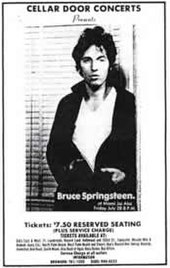
The E Street Band is an American rock band, and has been musician Bruce Springsteen's primary backing band since 1972. The band was inducted into the Rock and Roll Hall of Fame in 2014. For the bulk of Springsteen's recording and performing career, the band consisted of: guitarists Steven Van Zandt, Nils Lofgren, and Patti Scialfa, keyboardists Danny Federici and Roy Bittan, bassist Garry Tallent, drummer Max Weinberg, and saxophonist Clarence Clemons.

The Bruce Springsteen with the Seeger Sessions Band Tour, afterward sometimes referred to simply as the Sessions Band Tour, was a 2006 concert tour featuring Bruce Springsteen and the Sessions Band playing what was billed as "An all-new evening of gospel, folk, and blues", otherwise seen as a form of big band folk music. The tour was an outgrowth of the approach taken on Springsteen's We Shall Overcome: The Seeger Sessions album, which featured folk music songs written or made popular by activist folk musician Pete Seeger, but taken to an even greater extent.

The Devils & Dust Tour was a 2005 concert tour featuring Bruce Springsteen performing alone on stage on a variety of instruments. It followed the release of his 2005 album Devils & Dust. The tour was named the Top Small Venue Tour of 2005 by the Billboard Touring Awards.

The Rising Tour was a lengthy, worldwide, top-grossing concert tour featuring Bruce Springsteen and the E Street Band that took place in arenas and stadiums over 2002 and 2003. It followed the release of their 2002 album The Rising.

The Bruce Springsteen and the E Street Band Reunion Tour was a lengthy, top-grossing concert tour featuring Bruce Springsteen and the E Street Band that took place over 1999 and 2000.

The Bruce Springsteen 1992–1993 World Tour was a concert tour featuring Bruce Springsteen and a new backing band, that took place from mid-1992 to mid-1993. It followed the simultaneous release of his albums Human Touch and Lucky Town earlier in 1992. It was his first of four non-E Street Band tours. Later, Springsteen had more non-E Street Band tours, the Ghost of Tom Joad Tour, the Seeger Sessions Tour, and the Devils & Dust Tour. The tour was not as commercially or critically successful as past tours, due to poor reception of Human Touch and Lucky Town as well as changes from previous tours. According to Springsteen biographer Dave Marsh, die-hard fans have informally referred to the backing band as "the Other Band".

The Tunnel of Love Express Tour was a concert tour by Bruce Springsteen and featuring the E Street Band with the Horns of Love that began at the end of February 1988, four and a half months after the release of Springsteen's October 1987 album, Tunnel of Love. Considerably shorter in duration than most Springsteen tours before or since, it played limited engagements in most cities which fueled the high demand. The tour finally grossed US$50 million not counting merchandise. Shows were held in arenas in the U.S. and stadiums in Europe. A historic performance in East Berlin took place on July 19th 1988.

The River Tour was a concert tour featuring Bruce Springsteen and the E Street Band that took place in 1980 and 1981, beginning concurrently with the release of Springsteen's album The River.
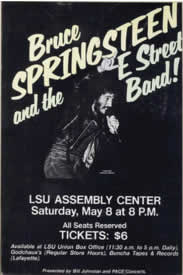
The Born to Run tours were the unofficially-named concert tours surrounding the release of Bruce Springsteen's 1975 album Born to Run which occurred between 1974 and 1977. The album represented Springsteen's commercial breakthrough, and was marked by a grueling and meticulous recording process. To make ends meet Springsteen and the E Street Band toured constantly during the first set of recording sessions for it, performing his new songs as he developed them. Financial success was short-lived, however, as he was soon plunged into legal battles with his former manager Mike Appel and enjoined from further studio recording. Touring continued as a means of making a living, long after the conventional period of playing in connection with an album's release was over; only when his legal issues were finally resolved in 1977 did these tours conclude.
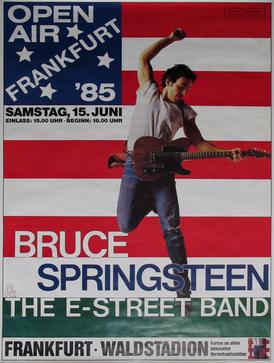
The Born in the U.S.A. Tour was the supporting concert tour of Bruce Springsteen's Born in the U.S.A. album. It was his longest and most successful tour to date. It featured a physically transformed Springsteen; after two years of bodybuilding, the singer had bulked up considerably. The tour was the first since the 1974 portions of the Born to Run tours without guitarist Steven Van Zandt, who decided to go solo after recording the album with the group. Van Zandt, who was replaced by Nils Lofgren, would appear a few times throughout the tour and in some of the music videos to promote the album. It was also the first tour to feature Springsteen's future wife, Patti Scialfa.

The Magic Tour was Bruce Springsteen and the E Street Band's 2007–08 concert tour of North America and Western Europe.
"Backstreets" is a song by Bruce Springsteen from the album Born to Run, which was released in 1975. In the original vinyl release, it concludes side one of the record.
"Racing in the Street" is a song by Bruce Springsteen from his 1978 album Darkness on the Edge of Town. In the original vinyl format, it was the last song of side one of the album. The song has been called Springsteen's best song by several commentators, including the authors of The New Rolling Stone Album Guide.
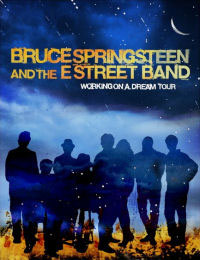
The Working on a Dream Tour was a concert tour by Bruce Springsteen and the E Street Band, which began in April 2009 and ended in November 2009. It followed the late January 2009 release of the album Working on a Dream. This was the first full E Street Band tour without founding member Danny Federici, who died during the previous tour in 2008, and the final tour for founding member Clarence Clemons, who died in 2011.

The Wrecking Ball World Tour was a concert tour by Bruce Springsteen and the E Street Band to promote Springsteen's seventeenth studio album, Wrecking Ball, which was released on March 5, 2012. It was the first tour for the E Street Band without founding member Clarence Clemons, who died on June 18, 2011. The worldwide tour in support of the album, which ended in September 2013, reached 26 countries, the most ever for one of Springsteen's tours. The tour resumed in January 2014 to promote Springsteen's new album, High Hopes, and went under that album's name.

The High Hopes Tour was a concert tour by Bruce Springsteen and the E Street Band with special guest guitarist Tom Morello of Rage Against the Machine. The tour was seen as a continuation of his previous tour and was in support of eighteenth studio album, High Hopes, which was released in January 2014.

The Agora, Cleveland 1978 is a live album by Bruce Springsteen & the E Street Band, released in December 2014 and was the second official release through the Bruce Springsteen Archives.

Brendan Byrne Arena, New Jersey 1984 is a live album by Bruce Springsteen & the E Street Band, released in May 2015 and was the fifth official release through the Bruce Springsteen Archives. The show was originally recorded live at the Brendan Byrne Arena in East Rutherford, New Jersey on August 5, 1984.

LA Sports Arena, California 1988 is a live album by Bruce Springsteen & The E Street Band with The Horns of Love, released in July 2015 and the sixth official release through the Bruce Springsteen Archives. The show was originally recorded live at the Los Angeles Sports Arena in Los Angeles, California on April 23, 1988 during the Tunnel of Love Express.
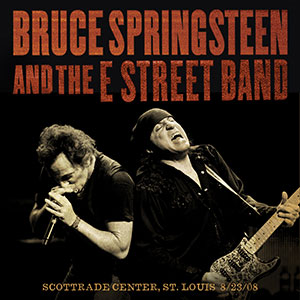
Scottrade Center, St. Louis, MO, 8/23/08 is a live album by Bruce Springsteen and the E Street Band, released on April 14, 2017. It is the twelfth official release through the Bruce Springsteen Archives. The show was originally recorded live at the Scottrade Center in St. Louis, MO on August 23, 2008, during the Magic Tour.
